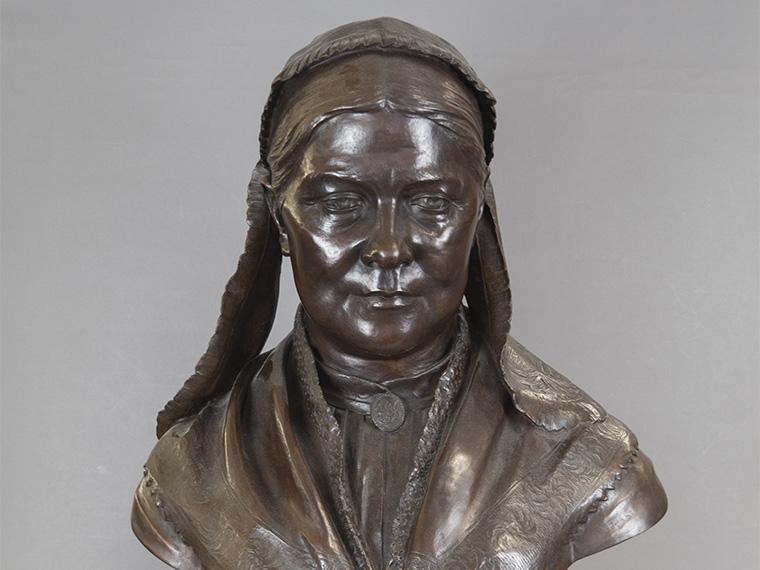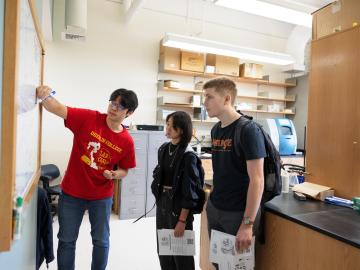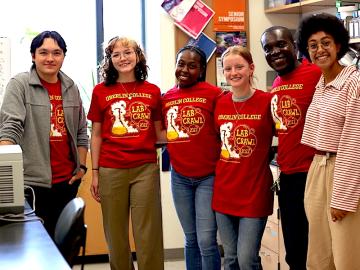Art in the Archives: Works Presented for the First Time
February 1, 2021
Anne Salsich, associate archivist, Oberlin College Archives

When Oberlin College moved to remote learning in March of 2020 in response to COVID-19, the Oberlin College Archives staff was required to identify and work on projects for remote work on short notice. As the associate archivist, my work primarily entails processing collections, managing the digital archive and the finding guide delivery database, and creating digital exhibits and collections. With remote access to the digital archive, I had an opportunity to create a new virtual exhibit from home.
While archives are not museums, they are often the keepers of visual works considered of enduring historical value to their institutions. Art in the Archives of Oberlin College, published in January 2021, showcases artworks and textiles with deep stories informing Oberlin’s rich history, of early post-secondary coeducation and the admission of Black students, antislavery, education in Asia, leadership in world affairs after World War I, an eclectic and notable built environment, and excellence in teaching and learning on campus. With one exception, a public sculpture, the works featured are housed in the college archives.
The chapters in the exhibit include Architecture in Visual Works, Drawings and Prints, Paintings, Photographic Objects, Sculpture, and Textiles. Many of the works had never been presented in an exhibit before; three were recent accessions. One example of a recent gift is an embroidered Chinese robe received in January 2020. It is emblematic of the College’s long and continuing history of involvement in Asia. It was a gift from H. H. Kung to the executive secretary of the Oberlin Shansi Memorial Association (OSMA) in the 1950s. Kung received his early education from Oberlin missionaries in Shanxi Province, China, just prior to the Boxer Rebellion. He came to Oberlin for his bachelor’s, and went to Yale for a master's in economics. After 20 years as principal of the Oberlin schools in Shanxi, he served in the highest positions of government and finance in China from 1928 to 1939, continuing his close relationship with OSMA in China and at Oberlin.

Photo credit: Courtesy of Oberlin College Archives
Another notable work with international significance in the textiles section of the exhibit is a gift from the Emir Faisal of the Arab Kingdom of Syria to Oberlin’s president, Henry Churchill King. Woodrow Wilson had appointed King as a co-leader of the King-Crane Commission in the Middle and Near East just after World War I. The Commission was charged with gathering petitions for self-governance from the peoples of the former Ottoman Empire to present at the Paris Peace Conference. The two garments, given by a daughter of Henry Churchill King, Oberlin’s president, were worn at a feast given for the Commission by Prince Faisal at his home outside Damascus. These fragile garments cannot be exhibited in an open library space, given the lack of adequate security and the special exhibit furniture and lighting they would require. This is a case in which the Archives holds unique materials that can only be exhibited in a museum setting, or online. The garments and many other works in the virtual exhibit were treated by the Intermuseum Conservation Association in Cleveland between 2008 and 2020 with endowed funds.
With this new virtual exhibit we hope to engage college and other visitors in exploring artworks with significant back stories that inform Oberlin’s history. When the campus is fully open again, we can draw on the virtual exhibition to develop physical installations, with iPads for visitors to access Art in the Archives of Oberlin College.
Tags:
You may also like…
Omar Tells His Story
October 11, 2024
This December, Oberlin will present a concert version of Rhiannon Giddens’ award-winning opera, both at Finney Chapel in Oberlin and the Maltz Performing Arts Center in Cleveland. Surrounding it are all kinds of cross-disciplinary events for campus and community.
Friday Afternoon with Lab Crawl
October 30, 2023
This year’s Lab Crawl drew what may be the largest crowd in the event’s illustrious history, with some 500 students and dozens of faculty taking part. Missed out on the excitement? It looked something like this.
Lab Crawl: It’s Not Just for Scientists
October 24, 2023
Oct. 27 open house highlights research across the sciences—and just about everywhere else.


